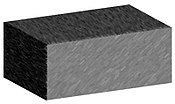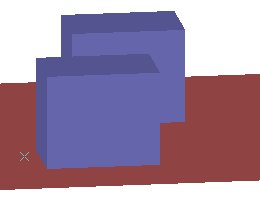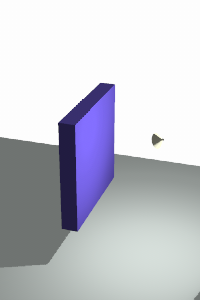| Revision as of 16:58, 14 October 2006 edit193.217.214.243 (talk) →Angle to Light Source← Previous edit | Revision as of 07:21, 22 November 2006 edit undo70.162.1.5 (talk) →Angle to Light SourceNext edit → | ||
| Line 11: | Line 11: | ||
| In Computer Graphics, '''Shading''' refers to the process of altering a color based on its angle to lights and its distance from lights to create a ] effect. Shading is performed during the ] process. | In Computer Graphics, '''Shading''' refers to the process of altering a color based on its angle to lights and its distance from lights to create a ] effect. Shading is performed during the ] process. | ||
| ===Angle to Light Source=== | ===Angle to Light Source=== | ||
| Shading alters the colors of faces in your 3D model based on the angle of the surface to the sun or other |
Shading alters the colors of faces in your 3D model based on the angle of the surface to the sun or other light sources. | ||
| The first image below has the faces of the box rendered, but all in the same color. Edge lines have been rendered here as well which makes the image easier to see. | The first image below has the faces of the box rendered, but all in the same color. Edge lines have been rendered here as well which makes the image easier to see. | ||
Revision as of 07:21, 22 November 2006
For other uses, see Shade (disambiguation).Shading refers to depicting depth in 3D models by varying levels of darkness.
Drawing

Shading is a process used in drawing for depicting levels of darkness on paper by applying more pressure with a drawing implement for darker areas, and less pressure for lighter areas. There are various techniques of shading including cross hatching where perpendicular lines of varying closeness are drawn in a grid pattern to shade an area. The closer the lines are together, the darker the area appears. Likewise, the farther apart the lines are, the lighter the area appears. The term has been recently generalized to mean that shaders are applied.
Light patterns, such as objects having light areas and shaded areas, help when creating the illusion of depth on paper and on computer screens.
Computer Graphics
In Computer Graphics, Shading refers to the process of altering a color based on its angle to lights and its distance from lights to create a photorealistic effect. Shading is performed during the rendering process.
Angle to Light Source
Shading alters the colors of faces in your 3D model based on the angle of the surface to the sun or other light sources.
The first image below has the faces of the box rendered, but all in the same color. Edge lines have been rendered here as well which makes the image easier to see.
The second image is the same model rendered without edge lines. It is difficult to tell where one face of the box ends and the next begins.
The third image has shading enabled, which makes the image more realistic and makes it easier to see which face is which.

Distance Falloff
Theoretically, two surfaces which are parallel, are illuminated the same amount from a distant light source, such as the sun. Even though one surface is further away, your eye sees more of it in the same space, so the illumination appears the same.
Notice in the first image that the color on the front faces of the two boxes is exactly the same. It appears that the is a slight difference where the two faces meet, but this is an optical illusion because of the vertical edge below where the two faces meet.
Notice in the second image that the surfaces on the boxes are bright on the front box and darker on the back box. Also the floor goes from light to dark as it gets farther away.
This Distance Falloff effect produces images which appear more realistic without having to add additional lights to achieve the same effect.


Light Sources

An OpenGL interface allows shadows from the sun. However with Ray Trace Renderers you can add light bulbs, flood lights and spot lights.
The intensity of the light is altered because of the angle of the surface to the light, the distance from the surface to the light, and because of the beam angle of the flood light.

Flat vs Smooth Shading
Flat shading is lighting technique used in 3D computer graphics. It shades each polygon of an object based on the angle between the polygon's surface normal and the direction of the light source, their respective colors and the intensity of the light source. It is usually used for high speed rendering where more advanced shading techniques are too computationally expensive.
The disadvantage of flat shading is that it gives low-polygon models a faceted look. Sometimes this look can be advantageous though, such as in modeling boxy objects. Artists sometimes use flat shading to look at the polygons of a solid model they are creating. More advanced and realistic lighting and shading techniques include Gouraud shading and Phong shading.
See also
3D computer graphics / Reflection and shading models.
Category: